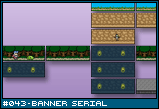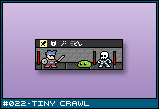| Three Hundred |
| - Index Page |
| - About... |
| - By Year |
| Collections |
| - Comp-Grid |
| - Procedural |
| - Tactics |
| - Tiny Crawl |
| - Misc |
| Previous | Mechanic #043 | Next |
![[serial1.png]](set03/img/entry043-serial1.png) The idea here goes back to the original banner game concept for [#022 - Tiny Crawl]. This is not a new idea for a banner game itself, but a way in which banners can be organized on a webpage to create a sort of serialized adventure, that players can go through. The core concept is the idea that you can grab a bunch of elements - elements created individually by different people - and sort of glue them together to make a narrative. It uses minor procedural generation concepts to provide that glue and to provide balance. The individual banners do not need to even be the same type of game, so long as each game knows how to glue itself to each other. So a horse riding banner would need a way to glue itself logically to a dungeon crawl banner and a mini-first person shooter banner in addition to another horse riding banner in a different themed area. The above example presents three banners. Three "mini-adventures". These banners could be for three different websites. Anyway, placing them next to each other connects them into a single adventure that the player can work through starting at the top left and moving right. That is, the same player moves between each banner as he completes them and his data gets moved to the next one in the path. (How this would be accomplished, I don't know - cookies maybe? Javascript? Java? Flash?) Each banner comes with a specific theme, like fantasy or scifi, and within that theme they'd know what other themes could be possible. Then, each banner manipulates the beginning and ending of the mini-adventure to set up the next adventure. For instance, after walking through the forest, mini-Maxim will find a cave entrance at the end indicating the next banner is a cave zone. The cave banner will then start with the entrance to the cave with light streaming in from the forest outside. ![[serial1b.png]](set03/img/entry043-serial1b.png) Another example could be a scifi version where players go from planets to a small sh'mup banner going between planets. The beginning and end of the space scene would have either the ship landing on a specific type of planet (lava planet, ice planet, forest planet) or hyperspacing to another space zone. The content of each banner would by dynamically balanced based on how far in the banner line it is. If it is the first banner, it will have easy enemies and crappy loot, while the last banner might put a boss end at the end. That way, if you place the same banners in the exact opposite order, it will still be a different experience.
![[serial2.png]](set03/img/entry043-serial2.png) To make things more interesting, banners don't have to go in a straight line. Since they would be placed in a grid, you could have paths dependent on certain criteria. In this example, the path branches twice (the zones are darkened so you can't see ahead - maybe, they'd show a corporate logo or something in the meantime). Anyway, maybe you get to that third banner and find two exits. Taking one exit will move your character to the upper right banner, and the other exit takes you to the lower right banner. Perhaps the paths could be based on failure - if you succeed, go up-left, or if you fail, bottom-right. ![[serial3.png]](set03/img/entry043-serial3.png) Or, you could have a very complex world built on banners. Here, the banners are used as "floors", such that if you go up, you move to the banner immediately above you. A zone would be built out of a group of like-themed banners. For instance, the top bunch represent the mountain zone, while the three blue caves make up a zone, as do the three gray dungeons. Each zone would be balanced according to its own rules based on size, shape, and paths. ![[serial4.png]](set03/img/entry043-serial4.png) The banners by no means need to be a single size, as long as there is some way to measure connections between them. I used a grid because it was visually obvious and easy to set up. So, you could make banners of different sizes to accomodate different games. Here, there are two large exploration banners, and a really long banner above it where a different type of game takes place (perhaps riding a horse and dodging arrows or something).
|


